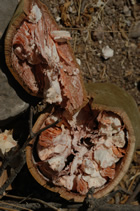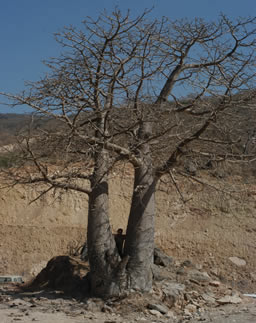Wadi Hinna is located at 240m altitude within the Dhofar limestone mountains. The mists of the Indian monsoon supply the area with humidity during the summer months, enabling a unique dry forest vegetation to grow. These closed forests have a high biodiversity; about 200 wooden species have been classified here, of which many are endogenous species. Succulents and thorny shrubs are typical for this vegetation; besides the famous baobab, we identify Anogeissus dhofarica, Acacia, Ficus, Euphorbia cactus and a flowering Euphorbia balsamifera, a species which can store water in its swollen trunk.
The trees shed their leaves during the dry and hot winter. Due to these xeric conditions, a great majority of the trees grow not more than two to three meters tall, except for the baobabs. The forest is also an important habitat for animals. We can hear and see a great number of different birds, and observe termites for the first time in Oman. In a gorge with a small water basin, the trees retain their leaves, ferns and reeds grow close to the water, we hear cicadas and see dragonflies and weaverbirds with their impressing nests hanging in the trees.
|
To read more, please download the full report by Sarah Preißel. Continue to "Frankincense and the Dhofar region". |

|

